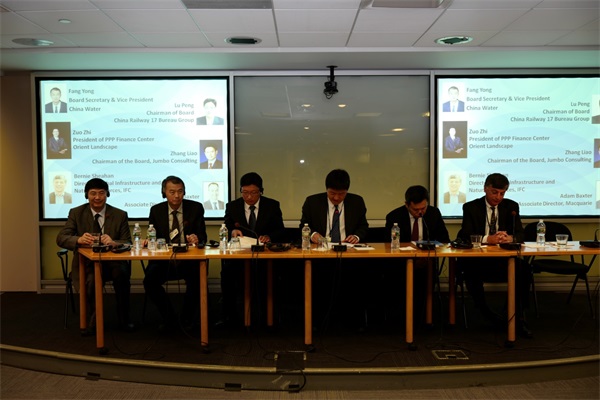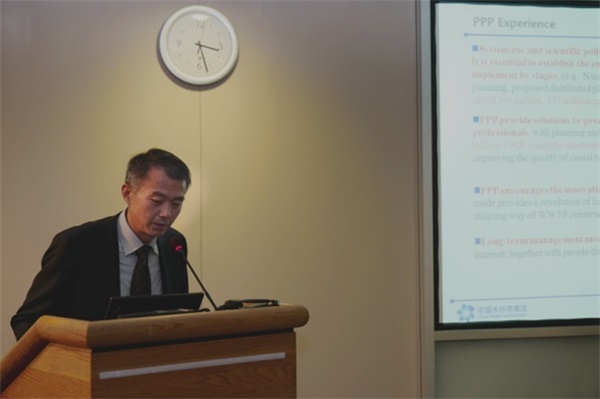CWEG Invited to Give a Keynote Speech at the International Seminar on “PPP Reform in China” Co-organized by the World Bank
2016-10-10 On October 7, during the World Bank Annual Meeting 2016, the International Seminar on “PPP Reform in China” co-organized by the Ministry of Finance’s China PPP Center and the World Bank successfully kicked off in Washington. For the first time, China introduces its PPP reform concept and achievements comprehensively and systematically to the international community, which will be of great significance to the further development of China""s PPP model.
The seminar attracted nearly 100 representatives from foreign governments, the World Bank and other international institutions, some provincial finance departments of China, and international and domestic enterprises. At the seminar, Deputy Finance Minister Shi Yaobin and World Bank Vice President Laura Tuck made addresses, and Jiao Xiaoping, Deputy Director of the China PPP Center, delivered a keynote speech. As a representative of the private sector, CWEG Vice President Fang Yong was invited to give a keynote speech in the session of “Private Participation in China’s PPP”, where he shared CWEG’s water environment management PPP demonstration projects and practices in PPP-based technical and model innovation.
 Deputy Finance Minister Shi Yaobin comprehensively introduced the PPP reform achievements of China in his address, highlighting the three characteristics of PPP promotion in China: namely, “high starting point”, “emphasis on innovation”, and “strong foundation”. First, in terms of “high starting point”, in the top-level system design for PPP reform, China has drawn on the experience and practices of countries with mature PPP markets. Second, in terms of “emphasis on innovation”, China has implemented a series of strategies to guide and encourage the development of green, low-carbon and social infrastructure PPP demonstration projects. Third, in terms of “strong foundation”, dedicated PPP regulation institutions such as the National PPP Integrated Information Platform Project Library have been set up to facilitate information disclosure.
Deputy Finance Minister Shi Yaobin comprehensively introduced the PPP reform achievements of China in his address, highlighting the three characteristics of PPP promotion in China: namely, “high starting point”, “emphasis on innovation”, and “strong foundation”. First, in terms of “high starting point”, in the top-level system design for PPP reform, China has drawn on the experience and practices of countries with mature PPP markets. Second, in terms of “emphasis on innovation”, China has implemented a series of strategies to guide and encourage the development of green, low-carbon and social infrastructure PPP demonstration projects. Third, in terms of “strong foundation”, dedicated PPP regulation institutions such as the National PPP Integrated Information Platform Project Library have been set up to facilitate information disclosure.
According to World Bank Vice President Ms. Laura Tuck, China is already a worldwide leader in infrastructure PPP and has laid down a sound policy framework through learning from good international practices. “The World Bank will be willing to help China with capacity building, to improve its ability in the preparation of PPP projects and transactions while ensuring quality and risk control, so as to make sure their compliance with the United Nations’ requirements for sustainable development,” she said.
Jiao Xiaoping, Deputy Director of the China PPP Center, introduced in detail the background, new connotation and latest progress of PPP reform in China. “Through three years of development, the role of China""s PPP reform in breaking the monopoly and unleashing market vitality has been verified preliminarily. This is a consequence of China’s focus on PPP standardization and transparency as well as effective expansion of the PPP market by learning from international experience based on the present national situation,” Jiao Xiaoping revealed, “The PPP reform, as a widespread consensus in China, will become a new engine for China to explore new development paths and patterns and boost economic development. In this context, China is expected to become the world’s largest regional PPP market.”
 Taking water environment management PPP projects that CWEG has successfully implemented as examples, CWEG Vice President Fang Yong concluded that the PPP model provides a new idea/way for governments lacking capital, technology and management abilities. The PPP-based project leaves professional fields to experts, in which the government is responsible for project supervision, and the parts of planning, design, investment, construction and operation are delegated to the private partner, ensuring the delivery of premium public services with the lowest cost. In the early stage of a PPP project, the key is to conduct systematic and scientific surveys, identify pollution factors and model the environmental carrying capacity, which lays a foundation for the project’s overall planning and phased implementation. The PPP model encourages technical and model innovation, helping the government establish a long-acting water environment management mechanism, to bring clean and clear rivers back and enable people to enjoy the fruits of ecological civilization.
Taking water environment management PPP projects that CWEG has successfully implemented as examples, CWEG Vice President Fang Yong concluded that the PPP model provides a new idea/way for governments lacking capital, technology and management abilities. The PPP-based project leaves professional fields to experts, in which the government is responsible for project supervision, and the parts of planning, design, investment, construction and operation are delegated to the private partner, ensuring the delivery of premium public services with the lowest cost. In the early stage of a PPP project, the key is to conduct systematic and scientific surveys, identify pollution factors and model the environmental carrying capacity, which lays a foundation for the project’s overall planning and phased implementation. The PPP model encourages technical and model innovation, helping the government establish a long-acting water environment management mechanism, to bring clean and clear rivers back and enable people to enjoy the fruits of ecological civilization.
The seminar attracted nearly 100 representatives from foreign governments, the World Bank and other international institutions, some provincial finance departments of China, and international and domestic enterprises. At the seminar, Deputy Finance Minister Shi Yaobin and World Bank Vice President Laura Tuck made addresses, and Jiao Xiaoping, Deputy Director of the China PPP Center, delivered a keynote speech. As a representative of the private sector, CWEG Vice President Fang Yong was invited to give a keynote speech in the session of “Private Participation in China’s PPP”, where he shared CWEG’s water environment management PPP demonstration projects and practices in PPP-based technical and model innovation.

According to World Bank Vice President Ms. Laura Tuck, China is already a worldwide leader in infrastructure PPP and has laid down a sound policy framework through learning from good international practices. “The World Bank will be willing to help China with capacity building, to improve its ability in the preparation of PPP projects and transactions while ensuring quality and risk control, so as to make sure their compliance with the United Nations’ requirements for sustainable development,” she said.
Jiao Xiaoping, Deputy Director of the China PPP Center, introduced in detail the background, new connotation and latest progress of PPP reform in China. “Through three years of development, the role of China""s PPP reform in breaking the monopoly and unleashing market vitality has been verified preliminarily. This is a consequence of China’s focus on PPP standardization and transparency as well as effective expansion of the PPP market by learning from international experience based on the present national situation,” Jiao Xiaoping revealed, “The PPP reform, as a widespread consensus in China, will become a new engine for China to explore new development paths and patterns and boost economic development. In this context, China is expected to become the world’s largest regional PPP market.”

 中国水环境集团
中国水环境集团









